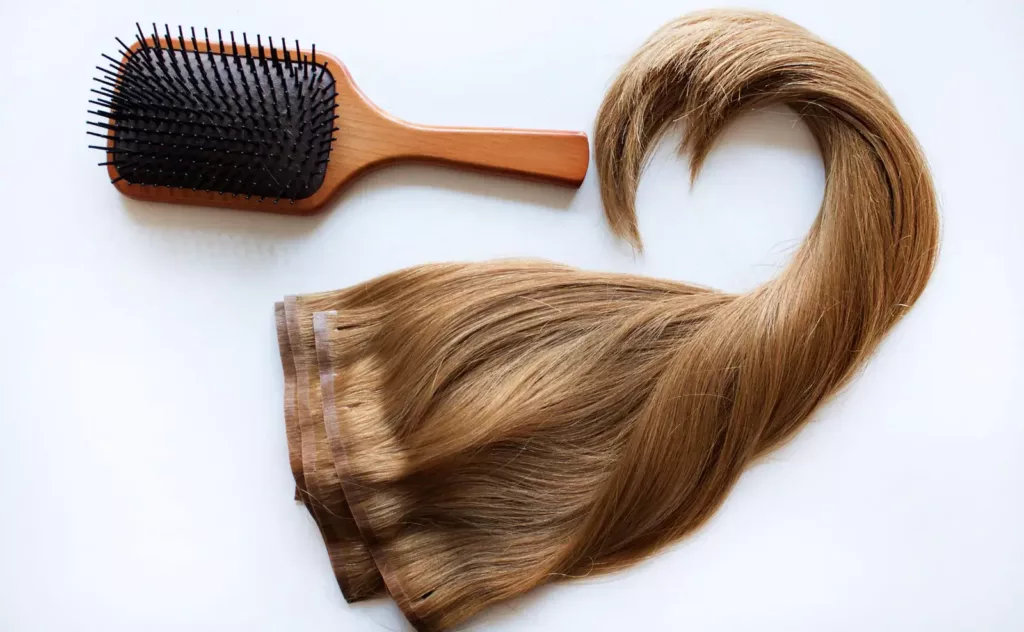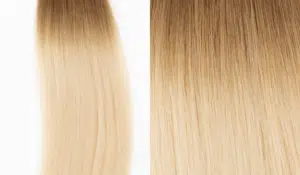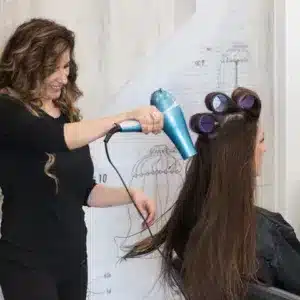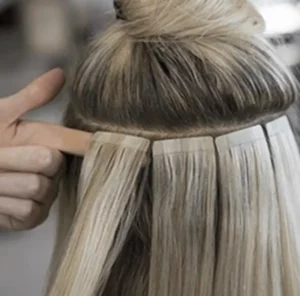Do your clip-ins tangle overnight or smell musty after a trip? Let’s fix storage today with simple habits that protect shine, shape, and time.
Store clip in hair extensions clean, fully dry, detangled, bundled by width, and protected from light, heat, and humidity. Use satin pouches or hanger cases, add labels, rotate sets, and never store damp hair.

Before tossing clip-ins in a drawer, set up a quick routine. Two minutes now saves twenty later. The next sections give daily steps, long-term methods, climate tips, inventory ideas, and fast fixes for common mistakes.
Why does storage matter for clip-ins?
Frizz, matting, and bent clips waste service time and reduce reusability. Clients see dull ends and uneven flow. Teams lose minutes with every prep.
Good storage protects the cuticle, preserves shape, and speeds setup. It also keeps colors clean, pairs clips correctly, and extends usable life across many wears.
Dive deeper
Storage is not only a box. Storage is a workflow that reduces friction before the next appointment or shoot. Clip-ins suffer in three ways: friction, moisture, and compression. Friction makes micro-tangles that turn into big knots. Moisture breeds odor and lifts color tone on light shades. Compression bends clips and crimps the first two inches of hair, which then require extra heat to re-shape. A simple end-of-day routine prevents all three.
Think in zones and time. Short-term storage covers tonight to tomorrow. Long-term storage covers weeks to months. Short-term prioritizes speed and airflow. Long-term adds dust control, humidity control, and shape protection. Team members need a clear map: what to do before a set goes into a pouch, which case to choose, and where to file it on the shelf. Clients need simple rules at home.
| Risk | Cause | Prevention | Result |
|---|---|---|---|
| Matting | Friction in bags | Detangle and bundle | Faster prep |
| Odor | Stored damp | Dry roots 100% | No rewash |
| Clip dents | Tight elastic or crush | Hanger with room | Smooth root area |
| Color fade | UV exposure | Opaque case | Tone stays true |
What should be done before storing clip-ins?
People rush. They fold and go. This saves minutes now and steals hours later. A quick pre-storage routine changes everything.
Before storage: detangle from ends to base, dry the roots fully, remove residue, align wefts by width, and secure with a soft tie. Keep products off the clips and fabric.
Dive deeper
Set a three-minute checklist. First, detangle. Support the clip area with one hand and use a loop brush or wide-tooth comb with the other. Always start at the last two inches, then work upward in short strokes. If the hair is freshly washed, apply a light leave-in only to mid-lengths and ends, not at the stitch line or clip fabric. Second, dry. Pat with a towel and air- or blow-dry until clips and stitch lines are bone dry. A damp base is the fastest way to get odor, corrosion on metal, and lifted stitching.
Third, residue removal. Wipe clips with a dry cotton pad to remove hairspray, powder, or tape dust from styling. Fourth, alignment. Lay wefts on a clean surface from shortest width to widest. Match left-right pieces so the next install is automatic. Fifth, secure. Use a satin ribbon or a soft scrunchie to create one gentle coil around the mid-lengths. Never cinch the clip zone.

| Step | Tool | Micro-rule | Why it matters |
|---|---|---|---|
| Detangle | Loop brush | Ends → base, support clip | Zero micro-breaks |
| Dry base | Towel + air/low heat | Clips 100% dry | No odor, no rust |
| De-gunk | Cotton pad | Wipe fabric and teeth | Clean grip later |
| Align | Flat surface | Small → large | Faster mapping |
| Secure | Satin tie | Avoid tight roots | No crimps at stitch |
How to store clip-ins for daily use?
Busy days need a fast, repeatable habit. Daily storage lives on the counter or in a drawer, not in deep boxes.
For daily storage, keep clip-ins clean, flat, and breathable. Use a satin pouch or a hanger case, coil gently, and place in a dark drawer. Never stack heavy tools on top.
Dive deeper
Daily storage favors speed and airflow. A satin pouch prevents friction and static, while a breathable hanger case maintains shape and keeps the root area straight. Choose one of two methods:
Method A: Satin pouch. Coil mid-lengths once, place clips aligned at one end, and slide into the pouch with the clip side facing up. This prevents pressure on the clips. Put the pouch in a drawer away from heat tools. Method B: Hanger case. Clip wefts onto a padded hanger with the clip teeth closed. Zip into a garment-bag-style sleeve. Hang in a closet with at least two inches of clearance on all sides.

Add a silica gel packet to control humidity if the climate is damp. Keep pouches and cases out of direct sun. Create a color card or small tag on the zipper ring with length, shade, grams, and texture. This small label saves minutes every time.
| Daily method | Best for | Pros | Watch-outs |
|---|---|---|---|
| Satin pouch | Home users, quick changes | Compact, travel-ready | Do not crush with tools |
| Hanger case | Salons and stylists | Keeps roots straight | Avoid tight clips or overstuffing |
How to store clip-ins for long-term and travel?
Long breaks flatten texture and invite moisture. Travel adds vibration, heat, and weight from luggage.
For long-term and travel, use rigid cases or hanger bags, add desiccants, wrap ends in tissue or silk, and avoid temperature swings. Keep sets labeled, flat, and off the suitcase bottom.
Dive deeper
Long-term storage battles time. Time means dust, light, and humidity. A rigid case prevents crushing. A black or opaque sleeve blocks UV. A desiccant pack keeps moisture down. Wrap the last six inches of hair in silk tissue to prevent friction in transit. If curls are pre-set, place large, soft foam rods to maintain shape without tight bends.
For travel, place the case in the middle layer of the suitcase, not at the very bottom where wheels transfer heat and vibration. Do not store clip-ins in a hot car or near a hotel window in direct sun. If traveling between humid and dry climates, open the case on arrival and let hair acclimate for ten minutes before styling. After each wear on the road, repeat the quick detangle and root-dry step, even if you skip a full wash.
| Scenario | Container | Add-ons | Placement |
|---|---|---|---|
| 1–3 weeks off | Rigid box | 1–2 silica packs | Dark closet shelf |
| 1–3 months off | Hanger bag + box | Silk tissue wrap | High shelf, no crush |
| Flights | Rigid travel case | Foam rods for curls | Middle of suitcase |
| Humid zones | Opaque case | Extra desiccant | Away from bathroom steam |
Which tools and environments work best?
Wrong tools scratch fabric and snag hair. Wrong rooms add heat and steam that warp clips.
Use loop brushes, wide combs, satin ties, padded hangers, opaque cases, and silica gel. Store in cool, dry, dark places. Avoid bathrooms, radiators, windows, and laundry rooms.

Dive deeper
Pick tools that respect the structure of the weft and the metal. A loop brush glides over stitches without pulling return hair. A wide-tooth comb opens big knots with minimal stretch. Satin ties hold bundles without leaving a groove. Padded hangers keep clips from biting into the hair.
Environment is half the battle. The best zone is a closet with steady temperature and low light. Bathrooms change humidity from showers; laundry rooms add heat; windows add UV. Heat dries ends and lifts tone on light blonde. Humidity swells fibers and encourages microbial odor. Add one small silica pack per pouch or case and replace every few months. If the climate is extremely dry, add a light leave-in to the last two inches before storage, but keep products off the fabric and clips.
| Item | Use | Avoid |
|---|---|---|
| Loop brush | Daily detangling | Ball-tip brushes that snag |
| Satin tie | Gentle bundling | Rubber bands that crease |
| Padded hanger | Root alignment | Wire hangers that dent |
| Opaque case | UV protection | Clear bags in sunlight |
| Silica gel | Humidity control | Fragrant sachets that transfer oils |
How should salons and wholesalers organize clip-ins?
Time is money on busy floors and in stockrooms. Clear labeling prevents mix-ups, missing pieces, and last-minute color hunts.
Organize by length, shade, grams, and texture. Use barcode or QR labels, keep set maps, and schedule rotation so each set rests between uses. Track sanitation and usage count.
Dive deeper
Create a simple schema: Length–Shade–Texture–Grams–SetID. Example: “18-#8A-Body-160-Set03.” Place this on a durable tag attached to the pouch or hanger case. Add a QR that links to a set card with date received, vendor lot, color notes, and a usage counter. Note any toning formulas or heat settings used, so future prep matches the history.
Plan rotation. High-use shades like neutral blondes and natural browns wear out faster. Rotate sets to balance wear. Keep “event-ready” sets ironed and wrapped for last-minute calls. For hygiene, log cleaning dates and method. For editorial work, store single-width fillers in a separate box with narrow slots and labels to speed placement around the face.
| Task | Practice | Payoff |
|---|---|---|
| Labeling | Length–Shade–Texture–Grams–SetID | Zero guesswork |
| Digital link | QR to set card | Instant history |
| Rotation | ABC priority by demand | Even wear |
| Hygiene logs | Clean date + method | Audit-ready |
| Filler box | Narrow slots by width | Faster detailing |
What mistakes ruin stored clip-ins, and how do we fix them?
Most damage comes from haste. The fixes are simple when caught early.
Common mistakes include storing damp hair, tight elastics at the root, UV exposure, overstuffed cases, and oil transfer. Fix with full root-dry, re-shaping with steam, chelating washes, and proper repacking.
Dive deeper
Damp storage causes odor and warps stitching. Solution: rewash if needed, then dry the clip base completely with airflow focused on fabric and teeth. Tight elastics crease the first inch of hair. Solution: mist lightly, then smooth with a paddle brush and a low-heat pass, finishing with a cool shot. UV exposure fades cool blondes to warm. Solution: use an opaque case; for discoloration, apply a gentle purple or blue toning mask to mid-lengths and ends only, then rinse and hydrate.

Overstuffed cases press clips into the hair and create zigzag dents. Solution: split the set into two pouches or use a hanger case with space. Oil transfer from scented sachets or hand creams adds slip at the fabric. Solution: clarify the stitch zone with a small amount of sulfate shampoo on a toothbrush, rinse, and air-dry flat.
| Mistake | Symptom | Quick fix | Prevention |
|---|---|---|---|
| Stored damp | Odor, soft fabric | Rewash/dry base | Dry 100% every time |
| Tight elastics | Root crease | Light mist + low heat | Satin tie only |
| Sun exposure | Faded tone | Tone + hydrate | Opaque case |
| Overstuffing | Dents, bends | Split sets | Room in case |
| Oil transfer | Slippage at clips | Clarify stitch zone | No oils near fabric |
My opinion
We suggest you keep storage simple and standard. Clean roots, dry fabric, flat alignment, and soft bundling save the day. A satin pouch works for most people. A padded hanger case helps teams. Labels and silica packs pay off more than fancy boxes. Small habits extend life and cut prep time.
FAQ
Can I store clip-ins in the bathroom?
No. Steam and heat change humidity and cause odor, rust, and frizz. Use a bedroom closet instead.
Should clip-ins be stored hanging or flat?
Either works. Hanging keeps roots straight. Flat pouches save space. The key is zero crush and a dry base.
How do I store curled clip-ins without losing shape?
Let curls cool on large foam rods, then place in a rigid or hanger case with room. Avoid tight elastics.
Can I store clip-ins while slightly damp to air-dry in the pouch?
No. Always dry the base 100%. Damp storage causes odor and weakens stitching.
What products should I avoid before storage?
Avoid heavy oils near the fabric and clips. Keep leave-ins on mid-lengths to ends only.
How long can clip-ins stay stored?
For months, if clean, dry, and protected from UV and humidity. Refresh with a light wash and condition before wear.
How do salons label and track sets?
Use a tag with length, shade, texture, grams, and a SetID. Add a QR linking to a set card with usage count and cleaning dates.
Do silica gel packs help?
Yes. They control humidity in pouches and cases. Replace every few months.
What is the best container for long-term storage?
Opaque rigid case or hanger bag placed on a high, cool shelf with a silica pack and silk tissue wrap on the ends.
How to fix root dents from tight bands?
Mist lightly, brush smooth, pass a low-heat iron once, then set with a cool shot. Repack with a satin tie.
Can I keep clip-ins near a window in winter?
Avoid direct sun and heater vents. Temperature swings and UV fade color and dry ends.
Is vacuum sealing a good idea?
No. Compression can crease roots and trap moisture. Use breathable cases instead.
How often should I clean stored clip-ins?
Wash after several wears or heavy product use. If they sit for months, wash and condition before the next service.
Should I store different widths together?
Align by width and pair left and right pieces. Bundle as a set with a label to speed installs.
Any travel tips for quick changes?
Carry a small rigid case, a loop brush, satin ties, and two foam rods. Keep the case mid-suitcase, not at the bottom.
Conclusion
Store clip-ins clean, fully dry, detangled, and protected from light, heat, and humidity. Use satin pouches or hanger cases, add labels and silica packs, and never crush the clip area. Small habits extend life and cut prep time.
Hibiscus Hair Manufacturer has been dedicated to producing high-quality clip in hair extensions for 25 years and is a recognized leader in the industry. If you are interested in finding a reliable hair extensions supplier and wholesale for your brand, please visit our website for more information:
CLIP IN HAIR





